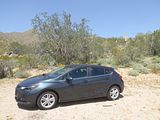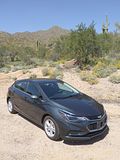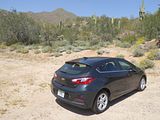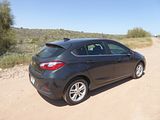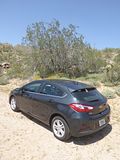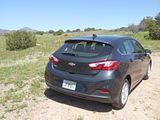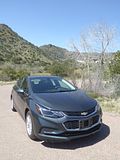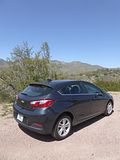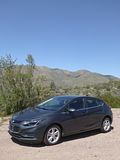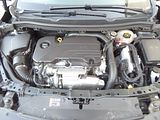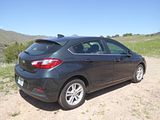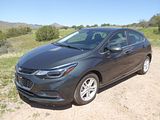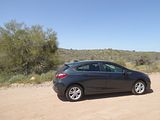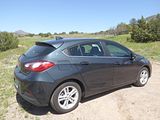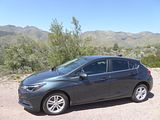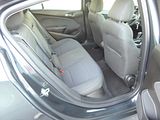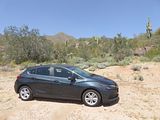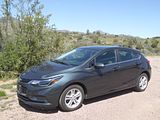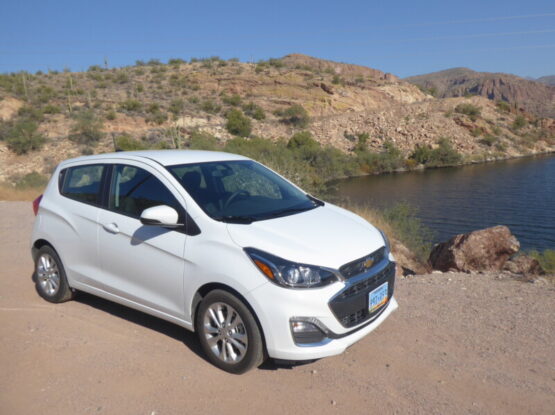By the early 1980s, almost all of the major European and Japanese brands had changed their product ranges to hatchback body styles in favour of the traditional three box saloon that they had been producing for decades. Only the brands that we would now think of as the “premium” ones held out, and they had a far smaller share of the market then they do now. The hatchback was seen as the perfect way to give customers more versatility and practicality in their everyday cars without needing to go as far as choosing an estate car, though of course these remained in most model ranges as well. The hatch definitely became the sine qua non of small cars, medium sized cars and its concept even extended into luxury models, with cars such as the Rover SD1, the Renault R20/30 and Saab 900 and 9000. But on the other side of the Atlantic, although there had a similar – but slightly later – move to front wheel drive and a considerable down-sizing from the “land yachts” of the 1970s, the regular saloon or “sedan” body remained what most manufacturers were producing. For whatever reason, Americans just did not take to the idea in the same way that the rest of the world had done. And that remains as true now as was 30 years ago. There are hatchback models offered on the US market, of course, but only really in what they would classify as “sub-compact” and “compact” classes, and in most cases there is a conventional saloon version also offered and where this is the case, it is the 3 box model which outsells the hatch and usually by a massive margin. Most of the available hatch models are there because they were conceived and have large markets elsewhere in the world. When Chevrolet devised their Cruze model, a medium-sized family car, which took the place of the unlamented Cobalt model in North America, they had massive global ambition for the car, with an intent of selling in excess of 1 million units a year across world markets, and in making it in more than a dozen different plants from America to Venezuela, Russia to Thailand, India to China and others. And so it was perhaps not a surprise that as well as the traditional saloon model which was first to appear, the range grew over time to include a 5 door Hatch and an Estate version. A few of these were sold in the UK and the rest of Europe before Chevrolet decided to leave Europe to their Vauxhall and Opel brands, so they were never a common sight, and they were never sold in America. By the time of the June 2015 launch of the second generation Cruze, the marketing plan had changed a bit, with the US model being conceived for that market, so it was no surprise that it appeared as a regular saloon, albeit one with a sloping rear end and quite a stubby tail. But for the 2017 model year, Chevrolet added a 5 door hatch version to the range as well. Not surprisingly, sales of this version have only constituted a small percentage of the Cruze models sold since then.
I spotted the first Cruze Hatch models in the Hertz fleet in early 2018, and so, although I had driven the regular Saloon version in September 2016, added it to the list of cars to try out at some point. It got to the top part of the list following the news that Chevrolet would cease production of the model and close the plant that builds the saloon versions, in Lordstown, Ohio, and the Mexican plant that builds the Hatch models would be making the new Blazer crossover instead, it seemed like the chance to try one would not be around for much longer. Every day in the Spring 2019 trip, as I wandered around the Hertz facilities first at LAX and then at Phoenix Sky Harbor, I noted that there there were plenty of Cruze models on offer, but they were all saloons, and then on a evening in Phoenix when total availability was very limited indeed, I spotted this one parked up. It was on Florida plates, as, I have noticed, are quite a few of the rare cars in the fleet, and although it was a 2018 model, it appeared in good condition and had not covered a massive mileage. After days of driving white car after white car, it was also a different colour, which in the rather gloomy lighting I thought could have been a dark blue, but the key said “grey” (well, actually, it said “gray”, as this is America and that is how they spell it!), and subsequent research informed me that the colour is called Nightfall Grey Metallic and it does indeed have a slight sparkle to it in the sunshine. It was in LT trim, so the same as the saloon model I had tried before, but one model year newer and of course with the different rear end. The timing of the test proved good, as I had literally just returned a Ford Focus Hatch and two days before that had been driving around in a US spec VW Golf, so not only could I assess the Cruze in absolute terms, but two of its direct market rivals were very fresh in my memory as well.
The 1.4 litre Turbo four that powered this car, and indeed the majority of US market Cruze models, develops 153 bhp, which is right on the class average. And average is really how you would describe the performance. The engine is smooth and decently willing, but generally unremarkable. It will be remembered more for the low noise levels and refinement when cruising than for the acceleration which is delivers, though that is going to be sufficient for everyday motoring and the car feels livelier once underway than when moving off from rest or low speeds. Although the Cruze has a few bhp less than the Focus I had been driving the day before, it really did not feel like it was down on power. To get the best out of it, you will need to work the engine quite hard, but the transmission is quite responsive to your intent in this regard, and so when I needed a burst of speed, or to keep momentum when going up the steeper inclines of the test route, there were no issues. There is a manual mode for the six speed automatic box, but I left the system to do what it thought best. In my previous test, I noted that there was a lot of travel between the different positions and whilst that was also the case here, I had fewer difficulties in moving the lever far enough to have made the desired selection. Largely because the majority of the test route for the Cruze was the same as that for the Focus, I covered an identical test mileage, of 163 miles. And when it came to filling it up, I had to put in exactly the same amount of fuel, 4.43 gallons, which computes to 36.57 mpg US or 43.69 mpg Imperial. This is a good result, though it is fair to say that there was no long haul on the freeway to reduce this, and no urban crawling either. Press reviews have generally commented on the good fuel economy for this model, though. Certainly, this is quite a bit better than the result with the Cruze Saloon in 2016 which delivered a result that was around 5 mpg less on what, as far as I can recall, was a very similar test route. There is a standard Stop/Start system, and much to the annoyance of many Americans, this cannot be disabled.
The other driving characteristics are equally competent and also rather undistinguished. The steering is light, so the car is easy to manoeuvre, but not so light that itis devoid of feel. Comparing it after a day with a Focus was always going to be a tough challenge, of course, and it is fair to say that if you were not convinced by how good the Ford was to steer and point down a twisty road, then a day with a competitor like this would show you the difference between OK and rather better. The Cruze sticks to the road, but there is understeer and some body roll if you get to the bends with your enthusiasm intact. The ride is well judged, proving soft enough to smooth out the bumps that you do find in Arizona, just not on the same scale as in California. There are 205/55 R16 wheels fitted and I thought the Cruze looked a bit like it could do with bigger, but that is a visual comment rather than a dynamic assessment. The brakes were fine, just as you would want them. I had no particular issues with visibility. There is quite a large area of metal work around the rear three-quarters for the hatch design, but this did not seem to present problems at oblique junctions or when reversing, and the now mandated rear-view camera certainly helped. The door mirrors gave a good field of view.
The interior of this Cruze looks exactly as I remembered the last one I drove to have been, and a comparison between the two showed that it is. Perhaps the most memorable feature is the rather odd decision to stick what looks like a piece of seat fabric on the dash, in front of the passenger, where you might otherwise find some form of inlay. There are other inlays, and these were a sort of grey plastic that were nearly as naff looking as the ones in the Focus. Otherwise, what you get is a generally cohesive design, using a lot of GM stock parts of the moment, and some reasonable quality materials. It certainly does not get close to the Golf in terms of feeling like a quality product, but it is better than the Focus – just. There is a plastic moulded steering wheel in LT trim, which houses buttons for the cruise control, audio repeaters and also to select the digital info display you want that is the centrepiece of the instrument cluster. There are a series of menus for trip mileage data and other data points that you can choose from. Two large dials feature in the instrument display, with two smaller ones for fuel level and water temperature set up in the upper area between them. They are all clearly marked and easy to read. Two column stalks are used for indicator and wipers, with lights operated by a rotary dial on the dash to the left of the wheel. The centre of the dash contains the 7″ integrated colour touch screen for the MyLink infotainment system, which in LT spec means that you get XM Satellite radio, but not navigation, as well as GM OnStar and a 4G LTE WiFi hotspot. Apart from an on/off and volume and a tuning knob which sit beneath the unit, everything has to be done through the screen interface. It proved reasonably responsive, but a bit fiddly, so is something for when stationary and not whilst driving. Thankfully, the system does not include the air conditioning system, which operates from knobs and buttons located lower in the centre of the dash. There is a foot operated parking brake. A physical key is still needed to start the car.
LT spec means cloth trim and manual seat adjustment, with a bar under the seat for fore/aft movement. There is a height adjuster as well, but no means of altering the lumbar support. Combine this with a telescoping steering wheel, and I was quickly able to get the driving position I wanted. The seat proved decently comfortable, though I did not give it the ultimate test of sitting on it for many hours uninterrupted as happens with some test cars. The cloth covering was typical of the sort of material used, being fairly tough to the touch, which probably means it will last quite well.
The rear seat accommodation seemed just as it was in the saloon model. And that extends to the fact that you will need to duck slightly (even when you are my height!) to ensure your head clears the roof as you enter. Headroom once installed is just OK, with my head clearing the rooflining, but only by an inch or so. There is plentiful legroom and indeed this is often cited as one of the strengths of the Cruze. A drop down armrest, with cup holders in the upper surface is included in the spec, and you get just one map pocket, on the passenger seat to go with the small door bins for those odds and ends.
It is the boot that is the major difference between this and the saloon, of course. It is a reasonable size when the rear seats are erected. There is quite a sill to heave things over, and, unlike many rental cars, this one did come with a parcel shelf to protect the contents from any prying eyes. There is a space saver spare wheel under the boot floor, and space for a few small odds and ends in the moulding that sits around it. if you ever had to change the tyres, a standard size would not fit in here and would have to go in the boot, as is the case with many cars that come with a space-saver. More capacity can be created by folding the asymmetrically split backrests down. They simply fold forward, creating a flat and long load area. Inside the passenger cabin, there is a decently sized glovebox, a small cubby under the central armrest and bins on the doors for those bits and pieces.
For 2018, the US market Cruze is available in two bodystyles, with a choice of two different engines and there are four trim versions, all of which are available with the saloon body, but only the top two are offered if you want the hatch model. The base Cruze L sedan lists at just $16,975, which is not a lot of money for a car of this size. It is not as stripped out as you might fear. It is powered by the 1.4T 138 bhp engine, with a six speed manual gearbox. Inside you get a 7-inch touch-screen display, the Chevrolet MyLink infotainment system, a built-in 4G LTE Wi-Fi hot spot, a USB port, Bluetooth, Apple CarPlay, Android Auto, four speakers, power windows and doors, keyless entry, air conditioning, a rearview camera, automatic headlights, and Teen Driver assist. Next up, and also only available with the saloon body is the Cruze LS. The $18,525 LS sedan gets upgraded interior items, such as a three-spoke deluxe steering wheel and gives you the ability to swap out the manual transmission for an optional six-speed automatic for $1,000. The most popular model in the range is the Cruze LT, which was the spec of the test car, and is the one you see most often at the rental facilities. For the LT trim, you can pick between the sedan and the hatchback. Standard amenities include a six-speaker stereo, satellite radio, steering wheel-mounted audio and phone controls, cruise control, heated side mirrors, a 60/40-split-folding rear seat, and LED daytime running lights. Powertrain options include the turbocharged petrol engine with either a manual or automatic transmission or the 137 bhp turbodiesel engine with either a 6 speed manual or a 9 speed automatic transmission. Chevy also offers a few different packages with the LT, such as the Convenience package, which adds heated front seats, a proximity key, and an eight-way power adjustable driver’s seat for an extra $850. Prices for the LT range from $20,920 to $25,920. At the top of the range, and which you do also see in the rental fleets from time to time is the Cruze Premier. This comes with the turbocharged petrol engine and the six-speed automatic transmission. Extra features in this $23,520 sedan ($24,020 for the hatchback) include leather seats, a leather-wrapped heated steering wheel, heated front seats, an eight-way power-adjustable driver’s seat, push-button start, remote car starter, and ambient lighting.
My conclusion following a day with the Cruze Hatch is no different from that of the Sedan version: pleasant but unremarkable. There are no significant weak points at all, but equally, there is nothing to make this car stand out and make you want one over some very talented class rivals. That said, Cruze sales are still strong, with the US buyers doing deals to acquire the model in significant quantity, even if not quite as many are doing so as were a few years ago. And that makes Chevrolet’s decision to kill the model off seem a little puzzling. Like Ford, they have decided that the future increasingly lies with Crossover models, and so GM are hoping that if you were going to buy a Cruze, you would now be tempted by their Equinox instead. It’s a big gamble, and time will tell whether it was the right decision or not. Whilst there won’t be a US market Focus model to tempt buyers, either, the Japanese and Korean brands will still sell you a saloon or even, in the case of some of them, a hatch. And almost all of these rivals are at least as good, if not better products than the Cruze anyway, so they all could see an increase in their sales once the last of the 2019 Cruze models have been sold. We shall see. Meanwhile, the Cruze is bound to linger in the rental fleets for many months yet, and if you get one in the hire car lottery, it is nothing to shy away from, as it is perfectly fit for purpose if a rather inoffensive product.

















